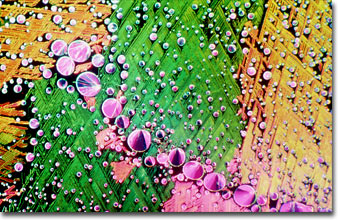Spike (M.I.) Walker
Diaminodiphenylmethane/Sulphur Complex
English photomicrographer Spike (M.I.) Walker has been a consistent winner of the Nikon Small World competition for many years and has published many articles and a book about microscopy. Featured below is a photomicrograph of a diaminodiphenylmethane mixture with sulphur.

|
The two materials (diaminodiphenylmethane and sulphur) were mixed together on a microscope slide and melted under a cover glass. As soon as melting of all the constituents was complete, the cover glass was pressed down in order to reduce the thickness of the preparation and the slide quickly removed from the hotplate (an inverted electric iron is a good substitute). The specimen was photographed under crossed polarized illumination. The objective was a plan apochromat 10x/0.32 NA coupled to an achromatic condenser. The microscope was a Zeiss Ultraphot III equipped with an automatic 35-millimeter photohead. The film was Fujichrome Velvia. (10x) |
Diaminodiphenylmethane, commonly referred to as dianilinemethane, is a weak nitrogen base having two analine moieties coupled to a methylene group at the para aromatic position. The chemical is highly toxic and crystallizes in light brown crystallites that slowly oxidize in air to form a darker oxidation product.
Sulphur is a nonmetallic chemical element belonging to the oxygen family (Group VIa of the periodic table) and is one of the most reactive of the elements. Pure sulfur is a tasteless, odorless, brittle solid that is pale yellow in color, a poor conductor of electricity, and insoluble in water. It was known to the ancients and referred to as brimstone in the Old Testament. Sulphur was first classified as an element in 1777 by Antoine Lavoisier and is estimated to be the ninth most abundant element in the universe. It makes up about 0.03 percent of the Earth's crust and is the most abundant constituent of minerals.
Free sulphur occurs primarily in volcanic or sedimentary deposits throughout the world, with heavy concentrations located in the sediments of the Gulf coast of North America. Sulphur compounds can be found in coal, petroleum, and natural gas and in sulfide ores such as pyrite (iron disulfide), galena (lead sulfide), cinnabar (mercury sulfide), sphalerite (zinc sulfide), and chalcopyrite (copper iron sulfide), as well as sulfates such as gypsum (calcium sulfate) and barite or heavy spar (barium sulfate).
